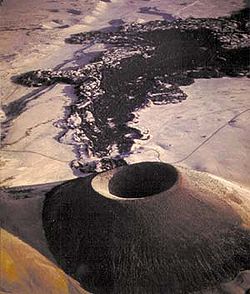Volcano Fields
Introduction
Volcano fields are unique ecosystems found around the world’s active volcanoes. A volcano field usually encompasses any number of active volcanoes clustered together in relatively close quarters. These environments are characterized by magma and ash as soil parent material and often exhibit early stages of succession in an ecosystem. Frequent disturbance of volcanic activity can prevent succession from proceeding to high orders. These eruptions can produce or displace magma, rock, or ash, depending on unique characteristics of every volcano or eruption event.
At right is a sample image insertion. It works for any image uploaded anywhere to MicrobeWiki. The insertion code consists of:
Double brackets: [[
Filename: SP Crater.jpg
Thumbnail status: |thumb|
Pixel size: |300px|
Placement on page: |right|
Legend/credit: Photo of the SP crater in the San Francisco Volcano Field
Closed double brackets: ]]
Other examples:
Bold
Italic
Subscript: H2O
Superscript: Fe3+
This template gives you a general idea of the layout of your page. You are not completely restricted to this format, so feel free to try out different things. I'll give you feedback as you work on your pages. Make sure to copy the "code" of this page to your own page before editing. -Prof Kent
In the introduction, briefly describe the habitat that is the topic of this page. Introduce the habitat, its ecological significance, and the importance of microorganisms in this environment. (What processes do they carry out? What functions do they perform?)
Physical environment
The physical environment of a volcano field is somewhat diverse, as the materials present can come from lava flows, or ash flows. Also, they change dramatically over time. A brand new lava flow is likely to have a high concentration of silicate, with significant amounts of aluminum, potassium, sodium, and calcium found throughout.
Very high concentrations of silicates cause lava to be an acidic environment, suitable for acidophiles, while less acidic flows are represented by a lower concentration of silicate material.
Subsection 1
Subsection 1a
Subsection 1b
Subsection 2
Biological interactions
Are there important biological interactions that are important in this environment? Do these interactions influence microbial populations and their activities? How do these interactions influence other organisms? Describe biological interactions that might take place in this environment, using as many sections/subsections as you require. Look at other topics available in MicrobeWiki. Create links where relevant.
Subsection 1
Subsection 1a
Subsection 1b
Subsection 2
Microbial processes
What microbial processes define this environment? Describe microbial processes that are important in this habitat, adding sections/subsections as needed. Look at other topics in MicrobeWiki. Are some of these processes already described? Create links where relevant.
Subsection 1
Subsection 1a
Subsection 1b
Subsection 2
Key Microorganisms
What kind of microbes do we typically find in this environment? Or associated with important processes in this environment? Describe key groups of microbes that we find in this environment, and any special adaptations they may have evolved to survive in this environment. Add sections/subsections as needed. Look at other microbe listings in MicrobeWiki. Are some of the groups of microbes from your environment already described? Create links to those pages. Specific microbial populations will be included in the next section.
Subsection 1
Subsection 1a
Subsection 1b
Subsection 2
Examples of organisms within the group
List examples of specific microbes that represent key groups or are associated with important processes found in this environment. Link to other MicrobeWiki pages where possible.
Current Research
Enter summaries of recent research here--at least three required
References
Edited by student of Angela Kent at the University of Illinois at Urbana-Champaign.

